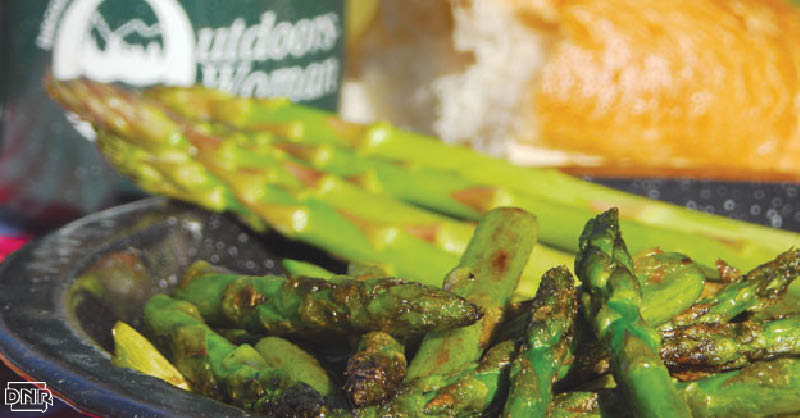 By Mike Krebill, from the March/April 2007 issue of Iowa Outdoors magazine
By Mike Krebill, from the March/April 2007 issue of Iowa Outdoors magazine
-- As always, when it comes to wild edibles, it’s always best to learn from an experienced forager. --
When I was young, I did not like asparagus. Perhaps because what I ate was old, overcooked, and out of season. But on a spring camping trip with a scout troop in Ames, I found a few spears of wild asparagus, and skeptically threw them into a pot of boiling water. Their bright green, unwrinkled appearance, low odor, and sweet, juicy, fresh taste was so appealing I changed my mind on the spot. The simple dish drew rave reviews from my companions. Now, you can’t keep wild asparagus away from me.
Stalking wild asparagus is a great family outdoor challenge. Together, learn to identify the wild plant, make contests of spotting, collecting and discovering favorite ways to cook and eat it. Here’s how to get started.
Get on the Hunt
Asparagus is hardest to find during the collecting season, from late April through the first week of June, but there are some clues. Old bushes from last fall have lost their golden color and many of their fine branches. Straw-colored and resembling slender, miniature Christmas trees minus the needles, they may be standing or may have fallen over. Search within three to four feet of their base, you might discover fresh spears. In May, look for one or two spears beginning to form a green bush that stands above the grasses around it.
Forager Challenge
Spotting wild asparagus is a game of patience as its abundance varies greatly. I once drove 34 miles in southeastern Iowa before finding any. Male plants have no berries; the female plants have hard round red berries, usually smaller than a pea in diameter, which birds eat. Typically found along roadside fences not far from farm gardens, where birds may have perched and dropped fertilized seeds, or on adjacent road banks, the delicate golden bush is easy to spot, even from a speeding car.
A spot I located last October was along a fence. From a distance, the golden cluster appeared to be three or four bushes. Up close, I marveled, counted 30 bushes, each formed from a separate asparagus spear that came up last year. My eyes opened wide and my mouth watered with the thought! The spot is worth revisiting, so I noted the location, and expect to visit it several times this spring.
Be aware that only the young spears, with no branches, are edible. The plant becomes toxic as the season progresses.
Mark Your October Calendar
Strangely, even though collected in the spring, it is easiest to locate in the fall when the plant turns into a one-stemmed golden bush with thin, lacy, needle-like branches. Search fence lines and road banks as you hike or drive, stopping to check possible sightings, inspecting the base of the plants for their hallmark resemblance to asparagus stalks. Make a family map of locations of the golden bushes. Encourage kids to think how they can find that spot again.
Follow up next spring, and collect, prepare and eat wild asparagus together for another memorable family activity. Take pictures for the family scrapbook, or e-mail them to relatives. But be careful: savvy morel mushroom hunters don’t divulge their favorite collecting places; neither should wild asparagus stalkers. Once you locate a great spot, silence is golden. Otherwise, friends and relatives will beat you there next spring.
Happy foraging!
Culinary Tips
Young asparagus tips can be eaten raw if you’re in survival mode or if you want a crunch in your salad. Most prefer tips cooked. However, make it brief, as overcooking destroys its bright green color and texture, impairs flavor and lowers nutritional value.
Harvest just before cooking, as asparagus loses its sweetness, juiciness and flavor within 24 hours. My favorite preparation is to steam for about five minutes, spray lightly with margarine or spread with butter, then sprinkle with a little lemon or orange zest (grated peel).
If camping, simply drop asparagus into boiling water for three minutes, drain, and add a little salt. Some prefer it with cheese sauce or in soup. It’s so incredibly delicious when fresh, many families insist on planting asparagus beds—but foraging is such fun, they may turn into confirmed foragers, and want to try other wild food adventures too.
Follow us on Pinterest for more Outdoor and Wild Recipes.
